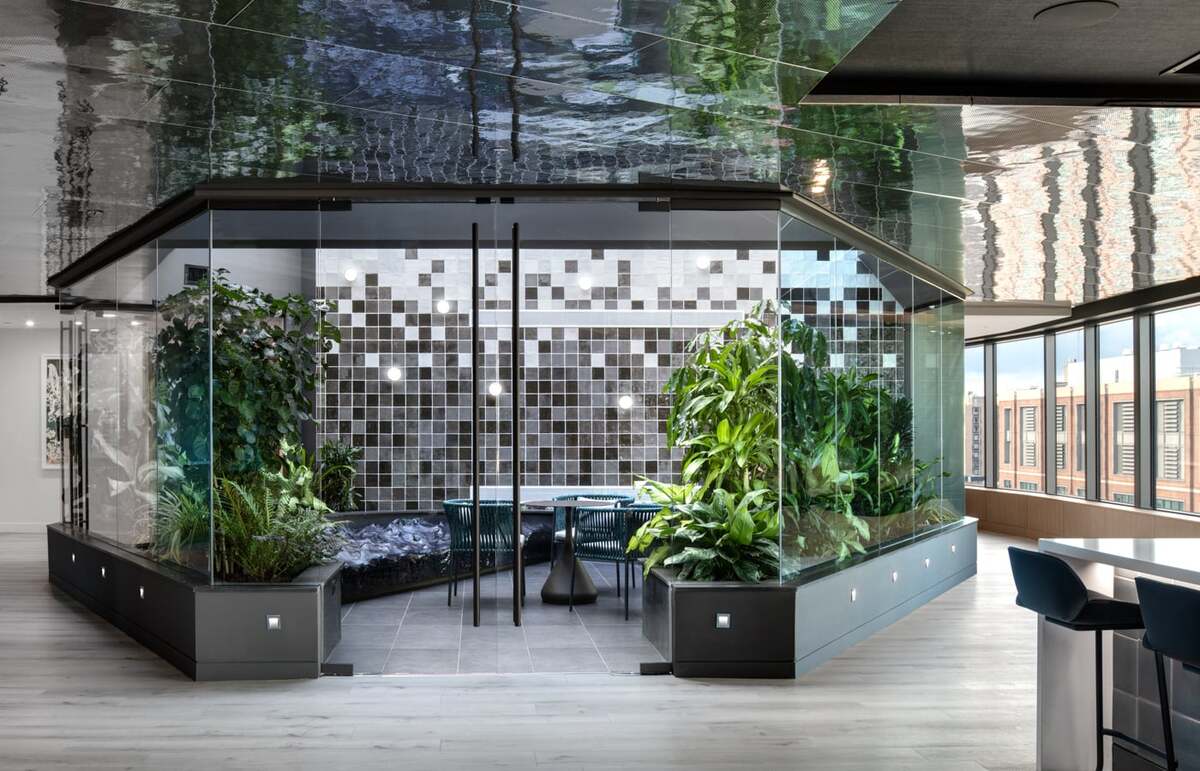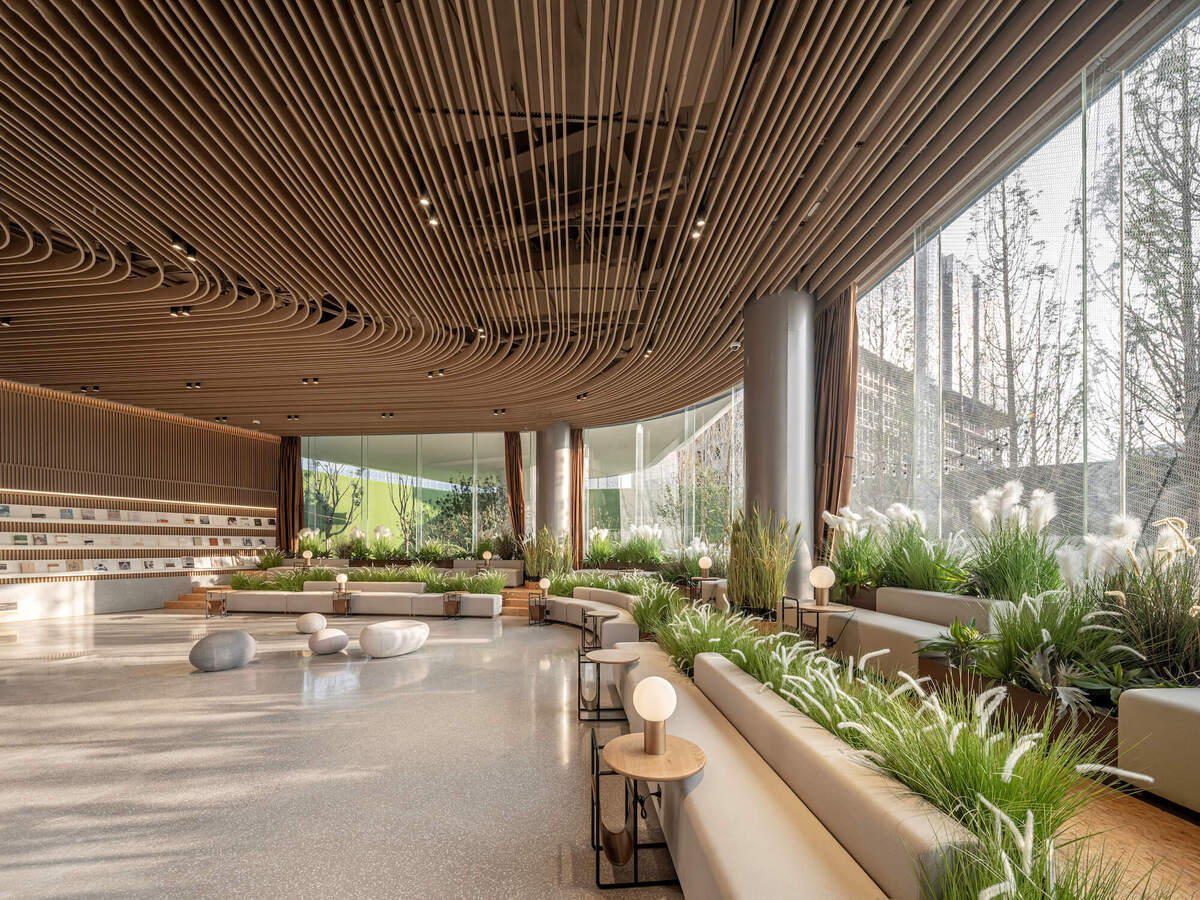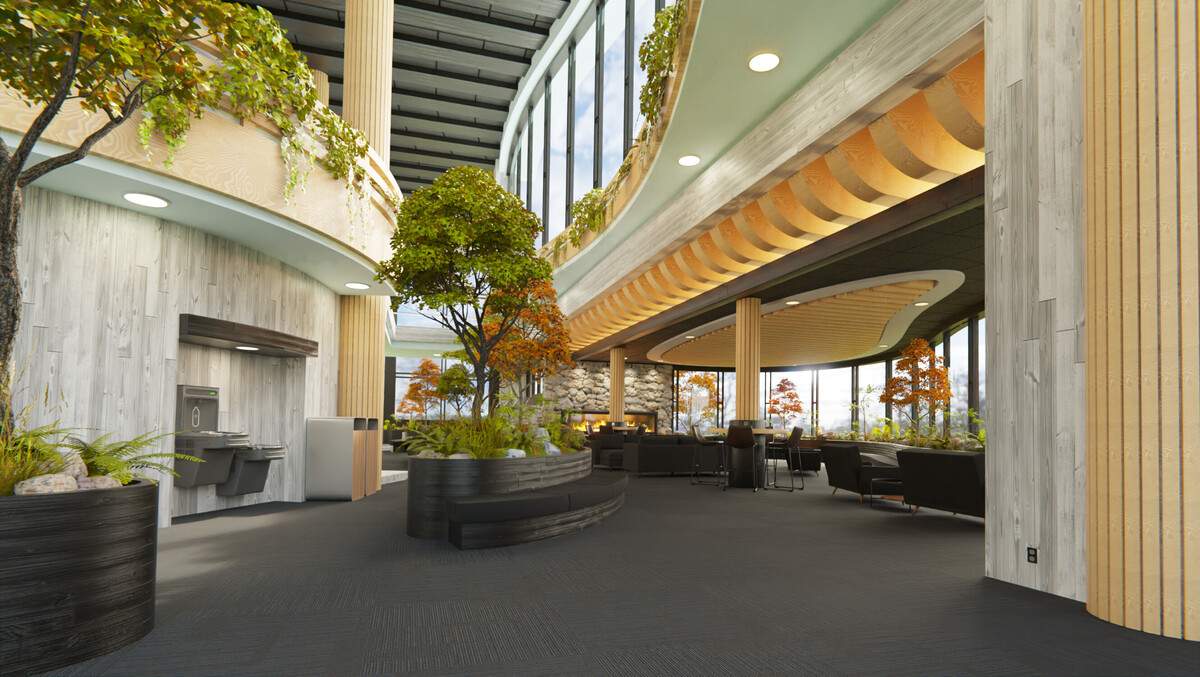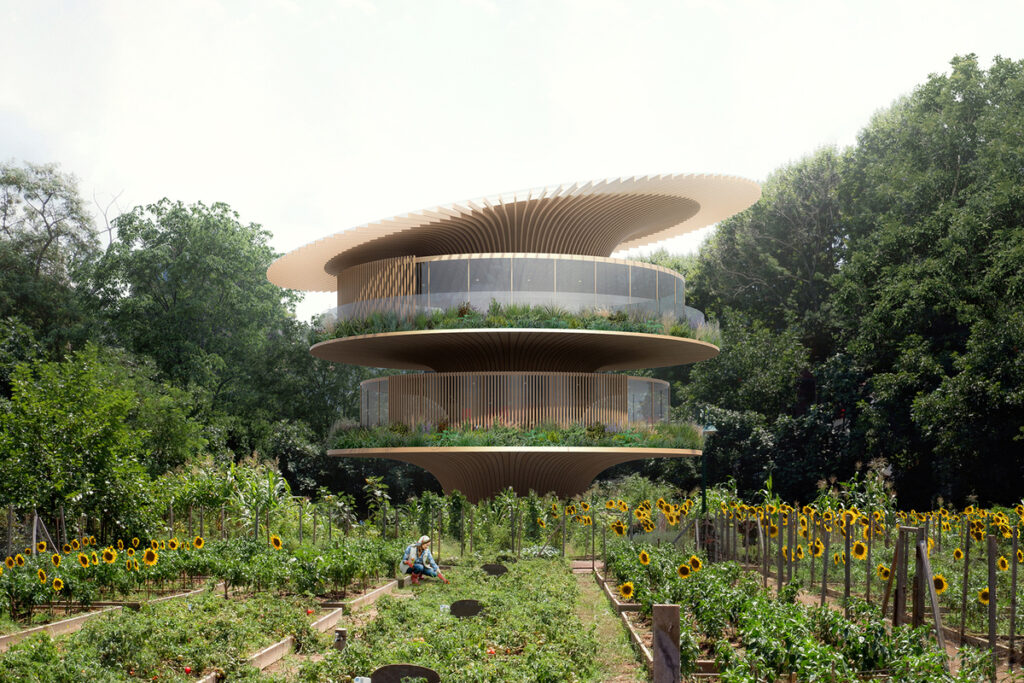In an era marked by rapid urbanization, technological advancement, and environmental degradation, the design of our built environments plays a crucial role in shaping the well-being of individuals and the sustainability of our planet. Amidst these challenges, biophilic architecture emerges as a transformative approach that seeks to reconnect people with the natural world, offering a holistic framework for creating healthier, more resilient, and more harmonious spaces.
According to recent statistics, more than half of the world’s population now resides in urban areas, a figure projected to rise to 68% by 2050. As cities expand and populations grow, the need for sustainable, human-centric design solutions becomes increasingly urgent. Furthermore, studies have shown that individuals spend an average of 90% of their time indoors, highlighting the importance of creating indoor environments that support health, productivity, and well-being.
Biophilic architecture, rooted in the biophilia hypothesis proposed by biologist Edward O. Wilson, recognizes humanity’s innate connection to nature and seeks to integrate natural elements into the built environment in meaningful ways. From incorporating green spaces and natural light to utilizing sustainable materials and biomimetic design strategies, biophilic architecture aims to evoke the restorative qualities of nature while promoting ecological stewardship and social cohesion.
This introductory guide explores the principles, benefits, challenges, and future trends of biophilic architecture, drawing upon historical precedents, case studies, and emerging innovations to illustrate its transformative potential. By harnessing the power of nature-inspired design, biophilic architecture offers a pathway towards creating healthier, more sustainable, and more resilient built environments that enhance the quality of life for individuals and communities worldwide.
Table of Contents
Historical Context
Biophilic architecture finds its roots in humanity’s deep-seated affinity for nature, dating back to ancient civilizations where people intuitively incorporated natural elements into their built environments. The concept gained formal recognition and exploration in the mid-20th century as architects and researchers began to delve deeper into the psychological and physiological effects of design on human well-being.
One of the earliest influences on biophilic architecture was the work of Frank Lloyd Wright, whose organic architecture principles emphasized harmony between human habitation and the natural world. Wright’s iconic Fallingwater (1935), with its integration into the landscape and use of natural materials, serves as a landmark example of biophilic design principles well ahead of its time.
In the 1960s and 1970s, the environmental movement brought increased awareness of humanity’s impact on the natural world, leading architects to reconsider their approach to design. Simultaneously, researchers such as Edward O. Wilson began to explore the concept of biophilia, the innate human tendency to seek connections with nature. Wilson’s groundbreaking book “Biophilia” (1984) laid the groundwork for understanding the psychological benefits of nature-inspired design.
Throughout the latter half of the 20th century, architects like Ken Yeang, known for his eco-friendly skyscrapers that incorporate greenery and passive design strategies, further advanced the principles of biophilic architecture. Concurrently, studies in environmental psychology and neuroscience provided empirical evidence supporting the positive impacts of nature exposure on human health and well-being, reinforcing the relevance of biophilic design in modern architecture.
The turn of the 21st century witnessed a resurgence of interest in biophilic architecture, fueled by growing concerns about urbanization, climate change, and the disconnect between people and nature in urban environments. Architects and designers began integrating biophilic principles into a wide range of projects, from residential buildings to corporate offices and public spaces, seeking to create environments that promote human flourishing while minimizing ecological footprint.
Today, biophilic architecture stands as a holistic approach to design that not only reconnects people with nature but also addresses pressing environmental and social challenges. As we move forward, the historical evolution of biophilic architecture serves as a testament to humanity’s enduring desire to coexist harmoniously with the natural world, shaping the built environments of tomorrow.

Principles of Biophilic Architecture
Biophilic architecture is grounded in the idea of creating spaces that foster a deep connection between humans and nature. These principles draw inspiration from the natural world and aim to enhance well-being, productivity, and sustainability in built environments. Here are some key principles of biophilic architecture:
- Connection to Nature:
- Incorporating natural elements such as plants, water features, and natural materials into architectural design.
- Creating opportunities for direct engagement with nature, such as courtyards, gardens, or rooftop terraces.
- Emphasizing views of natural landscapes or integrating nature-inspired artwork and patterns into interior spaces.
- Natural Light and Ventilation:
- Maximizing access to daylight through strategic placement of windows, skylights, and light wells.
- Providing ample ventilation to promote indoor air quality and create a sense of openness.
- Utilizing daylighting techniques to reduce reliance on artificial lighting and energy consumption.
- Biomorphic Forms and Patterns:
- Incorporating organic shapes, curves, and textures reminiscent of natural forms.
- Introducing biomimetic design elements inspired by biological structures and processes.
- Creating visually interesting and stimulating environments that evoke the complexity and beauty of nature.
- Materiality:
- Using sustainable, renewable, and locally sourced materials whenever possible.
- Showcasing natural materials such as wood, stone, and bamboo to evoke a sense of warmth and authenticity.
- Minimizing the use of synthetic materials and chemicals that may have adverse environmental or health impacts.
- Views and Vistas:
- Designing spaces to frame picturesque views of natural landscapes, water bodies, or greenery.
- Orienting buildings to optimize views and maximize exposure to natural light and scenery.
- Providing visual connections to nature from various vantage points within the built environment.
- Multisensory Experiences:
- Engaging all the senses through thoughtful design elements, including sights, sounds, textures, and aromas.
- Incorporating elements such as water features, wind chimes, and natural scents to evoke sensory experiences reminiscent of the outdoors.
- Creating spaces that encourage tactile exploration and interaction with natural materials and vegetation.
Suggested article to read: Sustainable Construction Technology; Ultimate Guide in 2024
By integrating these principles into architectural design, biophilic architecture seeks to create environments that promote human well-being, inspire creativity, and contribute to the overall health of the planet. Embracing biophilic principles offers a pathway towards sustainable, resilient, and harmonious built environments that benefit both people and the natural world.
Case Studies
These case studies demonstrate the diverse applications of biophilic architecture across different building typologies, showcasing how integrating nature into the built environment can create spaces that promote health, sustainability, and human connection with the natural world.
- The Edge, Amsterdam, Netherlands:
- This innovative office building, designed by PLP Architecture and developed by OVG Real Estate, embodies biophilic principles to enhance occupant well-being and productivity. Featuring extensive green roofs, indoor gardens, and atriums filled with lush vegetation, The Edge provides employees with abundant access to nature. The building’s intelligent systems optimize natural light and ventilation, reducing energy consumption while creating a comfortable and inspiring work environment.
- Amazon Spheres, Seattle, USA:
- Designed by NBBJ, the Amazon Spheres serve as a centerpiece of Amazon’s urban campus, providing employees with a unique biophilic workspace. These three interconnected glass domes house a diverse collection of plant species from around the world, creating a vibrant indoor rainforest environment. The Spheres offer employees spaces for collaboration, relaxation, and contemplation amidst nature, fostering creativity and well-being.
- Bosco Verticale, Milan, Italy:
- Bosco Verticale, or Vertical Forest, is a pair of residential towers designed by Stefano Boeri Architetti, characterized by their lush greenery-covered facades. The towers feature over 900 trees, 5,000 shrubs, and 11,000 perennial plants, which help improve air quality, reduce noise pollution, and provide habitat for wildlife. Bosco Verticale demonstrates how high-density urban developments can incorporate extensive vegetation to create livable, sustainable environments.
- Singapore Changi Airport, Jewel Terminal, Singapore:
- Jewel Terminal at Singapore Changi Airport, designed by Safdie Architects, redefines the airport experience with its stunning indoor garden and waterfall centerpiece known as the Rain Vortex. Spanning multiple levels, the lush greenery, natural light, and cascading water feature create a calming and immersive environment for travelers. The terminal integrates biophilic design elements seamlessly into a bustling transportation hub, offering passengers a rejuvenating respite amidst their travels.
- The Bullitt Center, Seattle, USA:
- The Bullitt Center, designed by The Miller Hull Partnership, is widely regarded as one of the world’s greenest commercial buildings. This six-story office building incorporates biophilic design strategies such as abundant natural daylighting, operable windows for natural ventilation, and a rooftop rainwater harvesting system. The Bullitt Center showcases the feasibility of achieving net-zero energy and water consumption while prioritizing occupant comfort and well-being through biophilic design.
Suggested article to read: Discovering the World’s Top 29 Sustainable Buildings

Benefits of Biophilic Architecture
Biophilic architecture offers a wide range of benefits that contribute to the well-being of occupants, the sustainability of buildings, and the health of the planet. Here are some key advantages:
- Enhanced Well-being:
- Biophilic design has been shown to reduce stress, anxiety, and fatigue while improving mood and cognitive function. Exposure to nature-inspired elements such as natural light, greenery, and views of nature can promote relaxation and mental clarity, leading to increased overall well-being.
- Increased Productivity:
- Studies have found that environments designed with biophilic principles can boost productivity and creativity among occupants. Access to natural light, green spaces, and views of nature can enhance concentration, problem-solving abilities, and innovative thinking, leading to improved performance in work and academic settings.
- Improved Health:
- Biophilic architecture can contribute to better physical health outcomes by promoting indoor air quality, reducing the prevalence of indoor pollutants, and supporting overall respiratory health. Additionally, exposure to natural light and outdoor views has been linked to better sleep patterns and regulation of circadian rhythms, which are essential for maintaining optimal health.
- Sustainable Design:
- Incorporating biophilic principles into architectural design can enhance the environmental sustainability of buildings by reducing energy consumption, minimizing waste, and mitigating the urban heat island effect. Features such as green roofs, living walls, and natural ventilation systems can help regulate indoor temperatures, reduce the need for artificial heating and cooling, and promote biodiversity in urban areas.
- Social Connection:
- Biophilic design can foster a sense of community and social connection by creating shared spaces that encourage interaction and collaboration among occupants. Green courtyards, communal gardens, and outdoor seating areas provide opportunities for socializing, relaxation, and recreation, strengthening social ties and promoting a sense of belonging within the built environment.
- Biophilic Education:
- Biophilic architecture can serve as a valuable educational tool for raising awareness about the importance of biodiversity, conservation, and environmental stewardship. Buildings designed with biophilic elements can inspire occupants to develop a deeper appreciation for the natural world and cultivate a sense of responsibility towards preserving and protecting it for future generations.
Suggested article to read: How to Improve Construction Productivity? Guide to 2024
Overall, biophilic architecture offers a holistic approach to design that prioritizes the well-being of occupants, the sustainability of buildings, and the integration of nature into the built environment. By embracing biophilic principles, architects, designers, and building owners can create spaces that not only enhance human health and happiness but also contribute to the preservation and restoration of the natural world.
Challenges and Considerations
Despite the numerous benefits of biophilic architecture, there are several challenges and considerations that architects, designers, and building professionals may encounter when incorporating biophilic principles into their projects. These include:
Cost Implications:
Integrating biophilic elements into architectural design can sometimes come with higher upfront costs compared to conventional building methods. Factors such as the selection of sustainable materials, installation of green infrastructure, and implementation of energy-efficient systems may require additional investments. Balancing the desire for biophilic features with budgetary constraints can pose a significant challenge for project stakeholders.
Suggested article to read: Construction Cost Estimating; Ultimate Guide for 2024
Maintenance Requirements:
Biophilic elements such as living walls, green roofs, and indoor plants require ongoing maintenance to thrive and remain aesthetically pleasing. Regular watering, pruning, pest control, and replacement of vegetation may be necessary to ensure the long-term viability of these features. Building owners and facility managers must allocate resources and personnel to properly maintain biophilic elements, which can be time-consuming and costly.
Suggested article to read: Building Maintenance; Comprehensive Guide 2024
Design Integration:
Successfully integrating biophilic design elements into architectural projects requires careful consideration of site conditions, building orientation, and occupant needs. Designers must strike a balance between incorporating natural features while ensuring functional and aesthetic compatibility with the overall design concept. Achieving seamless integration of biophilic elements within the built environment may require interdisciplinary collaboration and innovative design solutions.
Climate and Context Sensitivity:
Biophilic design strategies should be tailored to the specific climate, context, and cultural preferences of each project location. What works well in one climate or region may not be suitable for another. Architects and designers must conduct thorough site analysis and climate studies to determine the most appropriate biophilic interventions for optimizing thermal comfort, daylighting, and indoor-outdoor connectivity while minimizing environmental impacts.
Suggested article to read: Climate Change Impact on Buildings and Constructions; 2024 Review
Regulatory and Code Compliance:
Building codes, regulations, and zoning ordinances may present challenges for incorporating biophilic elements into architectural projects. Requirements related to fire safety, structural integrity, accessibility, and environmental sustainability must be carefully navigated to ensure compliance while still achieving biophilic design objectives. Engaging with local authorities and stakeholders early in the design process can help address regulatory constraints and secure necessary approvals.
Education and Awareness:
Despite growing interest in biophilic architecture, there remains a need for greater education and awareness within the design and construction industry. Many architects, developers, and clients may be unfamiliar with biophilic design principles or skeptical of their effectiveness. Building awareness and advocating for the benefits of biophilic architecture through research, case studies, and professional development initiatives can help overcome barriers and promote wider adoption of biophilic design practices.
Addressing these challenges and considerations requires a holistic and collaborative approach that involves stakeholders at every stage of the design and construction process. By navigating these challenges effectively, architects and designers can harness the full potential of biophilic architecture to create healthier, more sustainable, and more resilient built environments that benefit both people and the planet.

Future Trends and Innovations
As biophilic architecture continues to evolve, several emerging trends and innovations are shaping the future of sustainable design. These developments reflect a growing recognition of the importance of integrating nature into the built environment to enhance human well-being, promote environmental stewardship, and address pressing urban challenges. Some future trends and innovations in biophilic architecture include:
- Biophilic Urbanism:
- The concept of biophilic urbanism explores how cities can be designed and managed to maximize human-nature connections at the urban scale. Future urban developments may prioritize green infrastructure, biodiversity conservation, and equitable access to nature for all residents. Strategies such as green corridors, urban parks, and green roofs may become more widespread to promote urban biodiversity and mitigate the urban heat island effect.
- Biophilic Technology:
- Advances in technology are enabling new opportunities for integrating biophilic elements into architectural design. Innovations such as smart windows that mimic the qualities of natural light, biophilic lighting systems that simulate daylight patterns, and virtual reality experiences that immerse users in natural environments are reshaping the way we interact with built spaces. Future biophilic technologies may further blur the boundaries between indoor and outdoor environments, creating seamless connections with nature.
- Biophilic Materials and Fabrication:
- The development of sustainable materials and fabrication techniques is opening up new possibilities for incorporating biophilic elements into architectural projects. Biodegradable materials, bio-based composites, and regenerative building materials derived from natural sources are gaining traction as alternatives to conventional construction materials. Future advancements in material science may lead to the development of self-healing materials, biomimetic structures, and living building materials that actively contribute to environmental health and resilience.
- Biophilic Healthcare Design:
- In healthcare facilities, biophilic design is increasingly recognized for its potential to improve patient outcomes, reduce stress, and enhance healing environments. Future trends in biophilic healthcare design may include the integration of therapeutic gardens, nature-inspired artwork, and natural ventilation systems to create calming and restorative spaces for patients, caregivers, and staff. Evidence-based design approaches that prioritize human-nature connections are likely to become standard practice in healthcare facility design.
- Biophilic Retrofitting and Adaptive Reuse:
- Retrofitting existing buildings with biophilic design elements presents opportunities to revitalize aging infrastructure and improve occupant well-being without the need for new construction. Future trends may involve the adaptive reuse of underutilized urban spaces, industrial buildings, and historic structures to incorporate biophilic interventions such as green facades, atriums, and daylighting strategies. Biophilic retrofitting projects can contribute to urban revitalization efforts while reducing the environmental footprint of existing built environments.
- Biophilic Policy and Planning:
- Increasing recognition of the benefits of biophilic design is influencing policy and planning decisions at the local, regional, and national levels. Future trends may include the integration of biophilic design principles into building codes, zoning regulations, and sustainability standards to promote nature-centric urban development. Governments and municipalities may incentivize biophilic design through tax incentives, density bonuses, and certification programs to encourage the adoption of sustainable and health-promoting design practices.
Suggested article to read: Smart Windows For Smart Buildings; Comprehensive Guide 2024
Overall, the future of biophilic architecture is characterized by innovation, collaboration, and a renewed commitment to creating built environments that prioritize human well-being, ecological resilience, and social equity. By embracing emerging trends and innovations, architects, designers, and policymakers can pave the way for a more sustainable and harmonious relationship between people and nature in the built environment.
Conclusion
The journey of biophilic architecture from its historical roots to its present-day applications and future potentials represents a profound shift in how we conceptualize and design built environments. From ancient civilizations intuitively incorporating natural elements to contemporary architects consciously integrating biophilic principles, the evolution of this approach underscores humanity’s enduring connection to nature and its pivotal role in shaping our well-being and the sustainability of our planet.
The principles of biophilic architecture, rooted in fostering connections to nature, enhancing well-being, and promoting sustainability, offer a holistic framework for creating spaces that not only meet our physical needs but also nurture our innate biophilic tendencies. Through thoughtful integration of natural elements, daylighting strategies, and multisensory experiences, biophilic design has demonstrated its capacity to improve productivity, support health, and foster social connection in diverse settings, from offices and residences to healthcare facilities and urban spaces.
However, realizing the full potential of biophilic architecture requires addressing challenges such as cost implications, maintenance requirements, and regulatory constraints, while also advancing innovations in technology, materials, and policy. Embracing emerging trends such as biophilic urbanism, technological advancements, and sustainable materials can further propel the evolution of biophilic architecture towards creating more resilient, equitable, and regenerative built environments.
As we look to the future, biophilic architecture holds promise as a transformative force for addressing pressing urban challenges, mitigating climate change, and enhancing human well-being in an increasingly urbanized world. By embracing biophilic principles and fostering collaboration across disciplines, we can chart a path towards creating built environments that not only sustain life but also celebrate the inherent beauty and vitality of nature, enriching the lives of present and future generations alike.
Suggested article for reading:
Building Decarbonization; 2024 Guide
Reduce Carbon Emission in Construction; Ultimate Guide in 2024
Resources:
upgreen.io | Medium | Ambius | PSK Architect | Science Direct | Springer | RIBA Books
For all the pictures: The Green Cities Company | deskka | Blender Artists | Cristies’s International Real State



